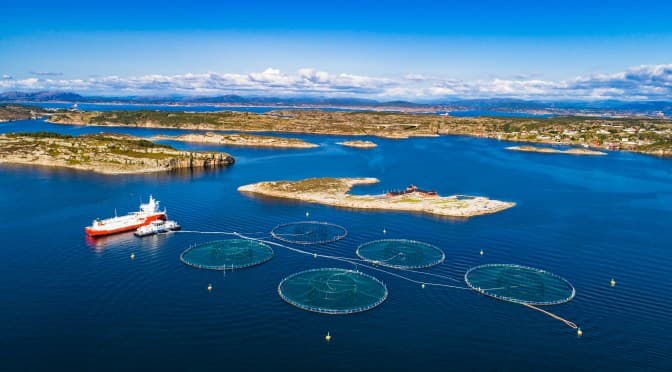
Aquaculture innovation gets a boost in Bergen
AQUACULTURE
Aquaculture Startup Ecosystem Takes a Step Forward with New Accelerator, via agfundernews.com
Norwegian aquaculture innovation received a boost this week, as Bergen welcomed the launch of Hatch, a new aquaculture startup accelerator.
Fish nutritionist Carsten Krome used his experiences in the Netherlands to help define the aims and objectives of the new unit. In particular, he focused in on addressing the need for aquaculture innovators to improve their investor readiness, which will be one of the central areas of focus of the immersive three-month programme.
The first cohort of eight startups will take residence in the city’s technology transfer office in the spring, each receiving €25,000 ($30,600) mentoring from industry specialists.
As mentioned in the article, it makes sound business sense to be in vesting in aquaculture. The global aquaculture market is expected to reach $219.42 billion by 2022, . For now, aquaculture tech is still a small segment, but it’s growing. Investments raised by seafood and aquaculture startups last year represented a 271% increase year on year.
Hatch applications are open until February 16 for the first intake, which will start activities in April.
EARTH OBSERVATION
Can Satellite Surveillance Help End Slavery in the Seafood Industry?, via modernfarmer.com
“We were kicked, punched, and beaten with sticks.” “I want to tell consumers that the seafood you are eating comes from our suffering… When you eat fish, please think about us.”
So rang out the words of enslaved Cambodian fishermen, speaking to Greenpeace interviewers about human rights abuses within the Thai fishing industry.
This sobering article highlights the full depths of this worrying and hidden area of abuse, and also details the new battlefront in the ongoing fight against it – space.
Greenpeace published research in December 2016 that revealed that five of the 30 Cambodian migrants found on one Thai illegal fishing vessel died at sea; the 25 survivors suffered severe malnutrition. The fishermen were held against their will for over a year. Within four months, the Thai government had issued mandatory recalls of its overseas fishing vessels, prosecuting and impounding 61 boats and insisting that the others employ satellite monitoring systems.
While organisations such as Global Fishing Watch and OceanMind are making great strides in using satellite tracking techniques to highlight vessels that may be involved in illegal fishing, the systems that they are developing can also help identify crews at risk of being held captive or otherwise exploited. For example, tracking “ghost ships” (those who turn off their Automatic Identification System) is now possible via sophisticated satellite techniques.
The ultimate aim of all of these systems is not of enforcement – catching those vessels who look like they're committing illegal acts – but to encourage a culture of compliance so that they don't commit crime in the first place. Whereas previously a nefarious captain could just switch off their AIS and hope to avoid detection, the new ability to track such ‘dark’ vessels makes them stick out like the proverbial sore thumb. The greater the coverage, and the more joined up enforcement agencies become, the fewer places there will be to hide.
Scientists working to predict fish-rich areas much in advance, via tribuneindia.com
Other satellite-enabled fisheries news emerged this week in India, again focused on good fisheries management using new sources of data intelligently.
Researchers from the CSIR-National Institute of Oceanography (CSIR-NIO) are using satellite imagery and underwater assets to accurately predict areas of abundant fish, nearly a month in advance.
The fishing industry currently reacts to daily intelligence provided by the Indian National Centre for Ocean Information Services (INCOIS), so being able to predict patterns much further in advance – by analysing satellite imagery from frontal zones and utilising underwater equipment like moorings and buoys to collect the data for long-term predictions – would be hugely welcomed.
CSIR-NIO is trying to understand why some frontal zones are having catch and some not, based on the chemistry, physics and biology of the ocean.
Rather than just enabling greater economic returns through the plundering of finite resources, though, the goal is actually achieving sustainable harvesting through sensible fisheries management.
ENVIRONMENTAL PROTECTION
Study finds strong support for ocean protection, via phys.org
And finally, very encouraging news as a new report reveals that the public widely believes that the marine environment is under threat from human activities, and supports actions to protect the marine environment in their region, according to a new study to be published in the February issue of the journal Ocean and Coastal Management.
The data set is impressive – over 32,000 people in 21 countries were surveyed and the results show that 70% of respondents believe that the marine environment is under threat from human activities, and 45% believe the threat is high or very high.
Pollution and fishing were identified as the key threats, followed by habitat alteration, climate change, and biodiversity loss.
With programmes such as Blue Planet prompting greater awareness of sustainability threats, and issues such as ocean plastic pollution rising rapidly in the public consciousness, this latest report provides the source of yet more evidence that will hopefully drive more effective environmental protections.
The differences of opinion in the public perception of major threats in different parts of the world – and how that compares to scientific understanding – make for fascinating reading.
Please check back next week for more Blue Economy Technology news.